Rigorous Program Yields Skillful Responders
Some students study as if their lives depend on it. Others study as if your lives depend on it —and they just might.
They’re part of the Emergency Medical Services (EMS) program at the Northeast Campus that since the late 1970s has produced the area's emergency medical technicians (EMTs) and paramedics.
These men – and, increasingly, women – are the first responders at scenes of mayhem and medical emergencies, arriving by ambulance, fire truck and helicopter. They work in uncontrolled conditions, seeing all sorts of illnesses and injuries. They must instantly draw on the storehouse of knowledge received from TCC instructors, -- not only what is to be done, but also why it is required and what the outcome should be. “They beat it into you,” said alumnus Miguel de la Rosa.
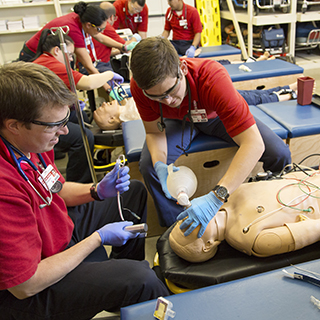 This is serious business, and the instructors make sure their students take it seriously.
“It’s not a joke, and they let you know that,” said de la Rosa, a MedStar paramedic
in Fort Worth. “They say, ‘If you come to me and have to take care of my mom, could
you do it?’ They set up the program to ensure that they would trust us with their
own mothers.”
This is serious business, and the instructors make sure their students take it seriously.
“It’s not a joke, and they let you know that,” said de la Rosa, a MedStar paramedic
in Fort Worth. “They say, ‘If you come to me and have to take care of my mom, could
you do it?’ They set up the program to ensure that they would trust us with their
own mothers.”
No wonder the EMS program is one of the most rigorous at TCC (and just about anywhere else). “If you look at a scale of one to 10,” said Jeff McDonald, program coordinator, “EMT is maybe a four or a five; paramedic is about a nine. The only thing harder than paramedic school is medical school. It’s tough. We expect an awful lot in a short period of time.”
The EMT course is the shortest. A single six-credit-hour course completed in one semester readies students to test for certification, and an additional 19 hours of other courses earns them a TCC Certificate of Completion.
Short, however, does not equal easy. “It was way more difficult than I expected,” said Alberto Ochoa, a firefighter/paramedic for the City of Coppell. “It really pushed me.”
But as rigorous as EMT is, he said, paramedic is an altogether different level. “It’s super difficult,” he said, ruefully admitting having to retake one part. “You have to be 100 percent focused.”
The EMT program each semester takes the first 108 who enroll, the limitation being the number of outside, real-world “clinical” spots available. The paramedic program, however, is one of TCC’s few special admissions programs to which prospective students must apply. The only criterion, other than EMT certification and having met the state’s Success Initiative requirement, is grade point average. If there are 60 applicants for 24 slots, those with the 24 highest GPAs get in.
McDonald would prefer an interview process for prospective EMT and paramedic students. “Most people have no idea what they’re getting into,” he said. “They think it (EMT) is just a first aid class, and they’re not really ready for the work. Some come in for the wrong reasons. It may look good on TV, but that’s not the real world.”
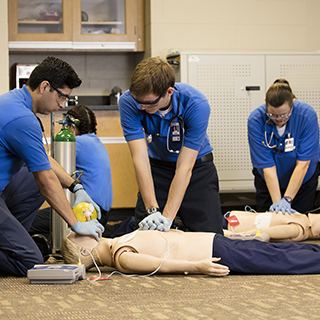 New paramedic students have a more realistic outlook, but foresight doesn’t guarantee
success, especially for those whose EMT training was somewhere else. Such students,
McDonald said, may have had very limited patient contact. “When we put them through
a more intense clinical experience,” he said, “some of them come back and say, ‘Well,
I finally saw some sick people, and I’m not ready for this.’”
New paramedic students have a more realistic outlook, but foresight doesn’t guarantee
success, especially for those whose EMT training was somewhere else. Such students,
McDonald said, may have had very limited patient contact. “When we put them through
a more intense clinical experience,” he said, “some of them come back and say, ‘Well,
I finally saw some sick people, and I’m not ready for this.’”
But while he would prefer an interview process, McDonald recognizes that it might admit the possibility of bias. Students with high GPAs will probably do well, he concedes, but not always. He remembers a streak of 10 years in which the highest-ranked students failed to complete the program.
Paramedics perform a much wider range of medical procedures than do EMTs, thus the more extensive curriculum – 33 semester hours spread over 16 months. These classes delve much deeper into subjects like trauma management, cardiology, medical emergencies, airway management and the special problems dealing with newborns, children and the elderly.
“These are things doctors look at on a constant basis, and we’re supposed to show up and immediately recognize, say, cardiac arrhythmia,” de la Rosa said. “And you’re cramming all this knowledge into a year and a half. If you don’t study religiously every day – before class and after class – you’re not going to make it.”
“It’s like they almost overeducate us,” said Elsa Garcia, a student in her last semester, “over-prepare us for what can come.”
Graduates, however, quickly learn to appreciate what instructors put them through, especially incidents drawn from their own experience. “I don’t know how many times I texted my instructor telling him I was so glad we had gone over a situation,” Ochoa said.
“You don’t really have time to think about things. The way TCC teaches us with hands-on training, it’s almost muscle memory. You walk into a situation and just do it.”
Elsa Garcia
The scarcity of minorities in emergency medicine concerns McDonald. “It’s a problem across the country,” he said. “There are not many non-whites and non-males interested in EMS, and that’s a hurdle we need to overcome.”
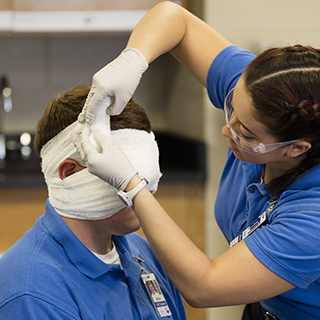 De la Rosa and Ochoa, as Hispanics, represent something of an anomaly in the paramedic
world, and Garcia much more so as a Hispanic female. Her father was very dubious about
her career choice, but she was fortunate enough to have an uncle who was a firefighter
and sort of smoothed things out. “I think it’s been just over the past year that my
dad has started to be okay with it.”
De la Rosa and Ochoa, as Hispanics, represent something of an anomaly in the paramedic
world, and Garcia much more so as a Hispanic female. Her father was very dubious about
her career choice, but she was fortunate enough to have an uncle who was a firefighter
and sort of smoothed things out. “I think it’s been just over the past year that my
dad has started to be okay with it.”
The quality of TCC’s program is no secret. De la Rosa was in El Paso when he decided to go to paramedic school. “I started asking people in the field. I went online,” he said. “Their name kept popping up – TCC, TCC, TCC. They seem to be what everyone talks about as the standard of what a good program is.”
What is the secret? Bedford Deputy Fire Chief Bobby Sewell is quick with an answer: “Jeff. When you think of TCC and Jeff, you’re thinking of greatness. It’s not just a job for him and his instructors. They’re saving lives by turning out people who have the knowledge and skills. He has the best paramedic program in the state and probably in the country. It’s a jewel for Tarrant County.”
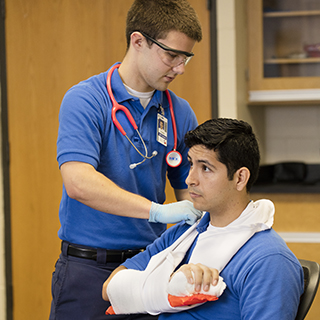 The numbers back up Sewell’s opinion. TCC graduates have passed the national paramedic
registry exam at a 96 percent rate over the last three years for which data are available.
The placement rate is 100 percent. According to McDonald, the job market is not great
for EMTs in Tarrant County because most agencies want paramedics. “But, if you’re
a paramedic in this county,” he said, “you can get a job in just about a week.”
The numbers back up Sewell’s opinion. TCC graduates have passed the national paramedic
registry exam at a 96 percent rate over the last three years for which data are available.
The placement rate is 100 percent. According to McDonald, the job market is not great
for EMTs in Tarrant County because most agencies want paramedics. “But, if you’re
a paramedic in this county,” he said, “you can get a job in just about a week.”
It is a rewarding job, more so in terms of service rather than salary, but it comes with a price. “I think everyone, at some point, doubts if they can make it,” said Garcia, one of 10 students remaining of her original class of 16.
“After the beginning, when you know what’s expected of you and have a passion for taking care of people, you’re going to fall into place,” de la Rosa said. “You know the instructors aren’t being mean to you. They’re being realistic. Life is not going to be forgiving.”

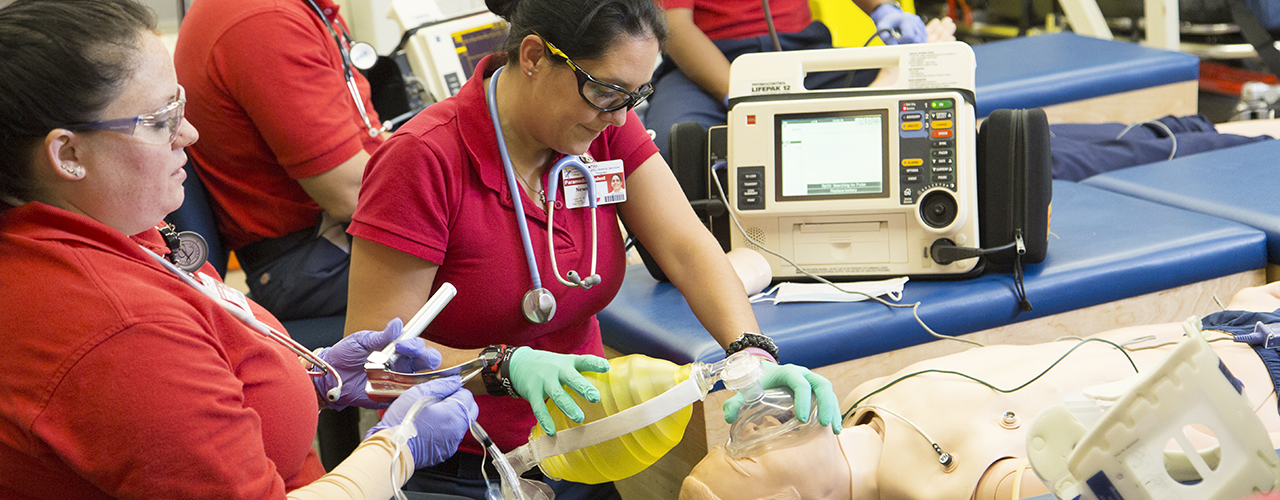
![//parameter[@name='author']](/magazine/assets/images/authors/bill-lace.jpg)